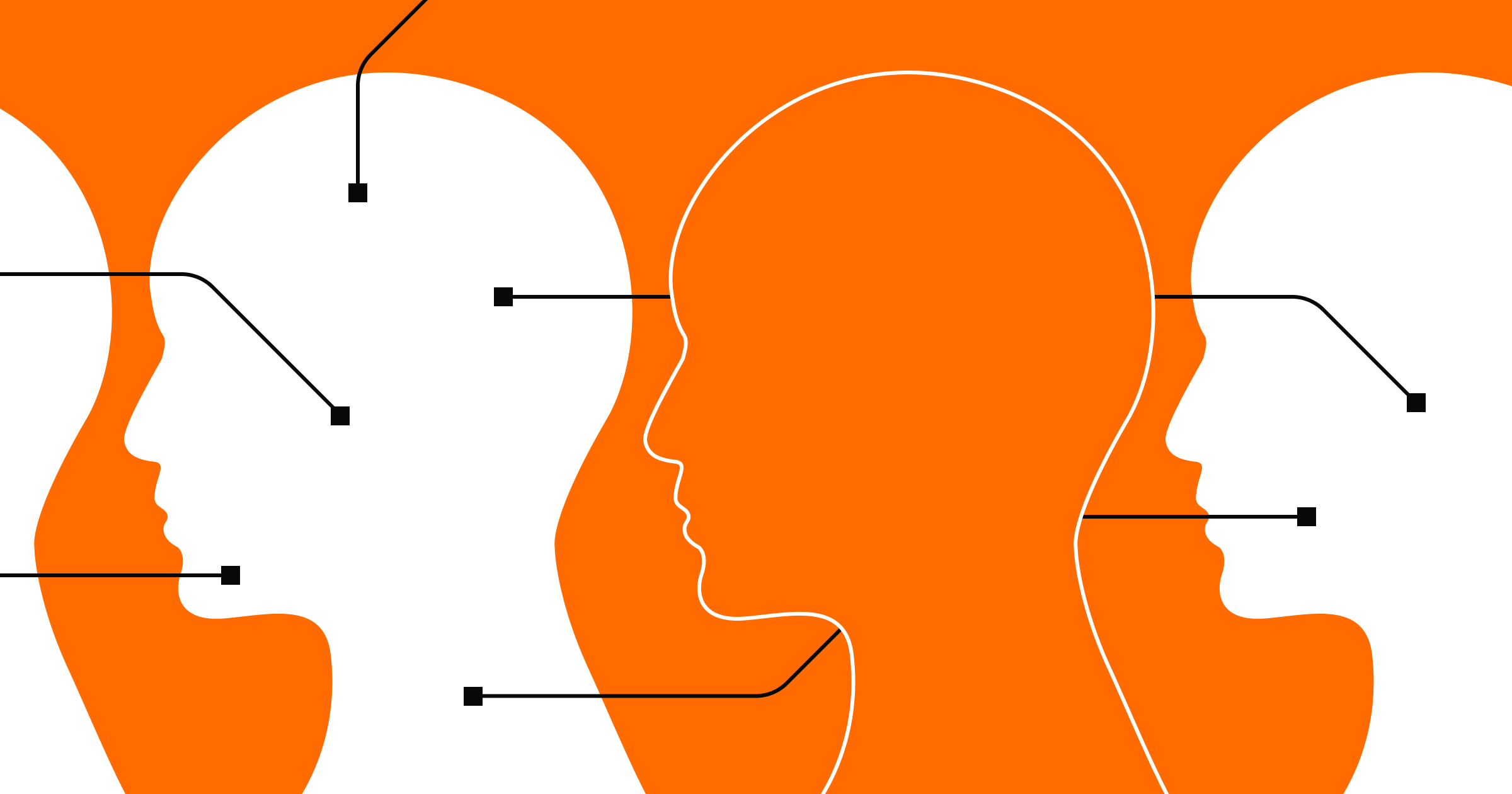In saturated markets, memorable customer experiences differentiate your brand and provide a competitive advantage.
Customer experiences go beyond mere transactions — they’re about creating journeys that enchant buyers, making them value, remember, and return to your brand. When customers feel satisfied, they’re more likely to become loyal advocates, promoting your brand and providing repeat business that fuels growth.
Here’s how to craft those experiences that attract and retain a devoted following.
What is customer experience?
Customer experience (CX) represents the collective perceptions, feelings, and reactions that customers develop based on their interactions with your brand. It encompasses every touchpoint a customer encounters — from when they learn about your brand to every subsequent interaction, whether it’s making a purchase, engaging with your website, or reaching out to customer support.
At its core, CX is about the emotions — trust, satisfaction, or frustration — evoked from these interactions. These feelings not only shape a customer’s perception but also influence their loyalty to a brand.
Why is customer experience important?
Understanding and maximizing customer satisfaction is crucial for driving success; a positive CX translates into customer loyalty, a positive brand reputation, and business growth. A poor CX puts you at risk of losing customers and damaging your company's image. Here's why it's crucial to prioritize your customer experience strategy:
- Cultivates brand loyalty. A consistently positive experience fosters trust and creates a strong emotional connection between your brand and its target audience. When customers feel heard, valued, and cared for, they’re more likely to choose your brand over its competitors, even when occasional hiccups or problems, such as delayed shipping or product issues, occur.
- Enhances customer retention. Customers supported by exceptional CX are more likely to return and become long-term brand advocates. Since retaining customers is more cost-effective than acquiring new ones, brands offering positive CX not only secure a steady revenue stream but also save money.
- Elevates brand reputation. Online reviews, social media posts, or website testimonials can bolster or tarnish a brand’s reputation. Delivering positive CX often leads to positive recommendations — powerful endorsements signaling your brand’s worthiness and credibility to potential customers.
- Offers a competitive advantage. In saturated markets, CX quality serves as a core differentiating factor. When elements such as price, product quality, and functionality are relatively similar within an industry or niche, offering memorable customer experiences distinguishes your brand from the competition.
- Drives visibility and growth. Beyond loyalty, great CX can translate to tangible business growth. Satisfied, returning customers not only provide a consistent revenue stream, they also actively refer the brand to their network. This word-of-mouth marketing, rooted in trustworthiness and authenticity, often carries more weight and reduces customer acquisition costs. Such genuine endorsements naturally bolster your online reputation, leading to increased organic traffic and enhanced search engine rankings.
Strategizing, measuring, and managing CX
To create a sustainable and effective customer experience framework, consider implementing these core processes.
Develop a customer experience strategy
Delivering excellent customer experiences begins with a well-crafted strategy. This strategy steers your marketing and design activities and aligns every initiative with your customers’ best interests. Here’s a breakdown of how to create an impactful CX strategy:
- Understand your target audience. Recognizing your audience’s preferences, needs, and challenges helps you tailor your offerings to meet their demands. If you run an ecommerce store, for example, and discover that your customers value fast delivery, adapting your operations to cater to this need can boost satisfaction and loyalty. To understand your target audience, consider analyzing existing purchase behaviors, studying customer demographics, and tracking online engagement metrics such as bounce and conversion rates. This approach creates detailed customer personas that help your CX initiatives resonate with your customers.
- Establish clear goals. Distinct objectives ensure your efforts align with larger organizational goals. For example, if you notice high shopping cart abandonment rates, setting goals around improving the checkout experience might lead to more impactful and measurable outcomes, optimizing resource use. To set clear goals, evaluate existing challenges within your CX. Then, outline specific, measurable, achievable, relevant, and time-bound (SMART) objectives that directly address these issues. Regularly revisiting and adjusting these goals aligns them with changing customer needs and business dynamics.
- Outline the buyer journey. Visually mapping the customer journey through diagrams or flowcharts gives you a holistic view of all interactions between your brand and its customers, enabling identification of potential pain points, well-performing areas, and engagement opportunities. By understanding every funnel stage, from initial brand interactions to post-purchase support, you can strategically invest in the most critical touchpoints, ensuring your customers feel valued at every step.
Measure customer experience metrics
CX metrics help gauge your effort’s effectiveness and compare progress to pre-established goals. Here's how to maximize data to drive success:
- Choose relevant metrics. Select key performance indicators (KPIs) and business performance metrics that reflect your business goals. If you aim to enhance interface navigation, for instance, focus on tracking organic traffic, bounce rates, and click-through rates. Selecting the right KPIs keeps you on track to achieve larger objectives and enables precise resource allocation.
- Collect data. Gathering data from various sources gives you a comprehensive understanding of your customers. Website analytics, such as dwell time and scroll-depth, provide insights into user behavior and preferences, while pop-up or email surveys let you gauge specific aspects of the user experience. For example, asking customers "How likely are you to recommend our product to friends and family on a scale of 1-10?" via email lets you measure your brand's Net Promoter Score (NPS), offering valuable feedback on overall customer satisfaction and loyalty. Regularly monitoring and collecting data prepares you to refine and enhance your CX, leading to stronger customer relationships.
- Analyze and interpret data. After collecting your data, analyze it to identify themes, patterns, and trends. Consider using data visualization tools or heat maps to simplify and understand complex user behaviors. For example, a high bounce rate on a product page might indicate content or layout issues. Identifying such patterns helps you make more informed adjustments, improving user engagement and optimizing your marketing efforts. If a campaign draws traffic but not engagement, you might reconsider revamping the landing page’s design or content.
Customer experience management
Effective customer experience management (CEM) hinges on the deliberate design and fine-tuning of customer interactions to meet and exceed their expectations. Use these tips to maximize your efforts based on insights from data analysis and customer feedback:
- Implement strategic changes promptly. After analyzing data, begin brainstorming and implementing adjustments to improve the customer experience. For example, if you discover customers abandoning their cart before purchasing, streamline the checkout process by introducing a one-click system. Minimizing purchase barriers encourages customers to follow through with conversion, leading to a more efficient buying process and increased sales.
- Regularly collect feedback. Create a system that harvests insights from your customer base, such as post-purchase surveys or prompts for online reviews. This ongoing feedback stream helps you identify CX areas that need improvement and demonstrates to customers that you value their input. When customers see their suggestions bring about tangible change, it fosters increased brand loyalty and satisfaction.
- Invest in employee training. Your employees serve as brand ambassadors, so it’s important they not only understand the overarching CX strategy but also have the necessary skills to execute it flawlessly. To train your team, consider a blend of learning methods like workshops, e-learning, and practical simulations, which cater to a variety of learning styles. Then, regularly update your training content to reflect evolving customer service practices, integrating feedback from customers and employees, ensuring your training program remains dynamic and effective.



















Don't let traditional CMS solutions hold you back
Your website is only as good as your CMS. In our whitepaper, learn why a visual-first CMS can help you business scale and build powerful web experiences.
4 tips for improving customer experience
Improving CX is a collaborative effort involving multiple departments, from marketing and UI/UX teams to customer service representatives, dedicated to crafting experiences that aren’t just visually appealing but also intuitive and user-friendly. To elevate your CX, consider these tips:
1. Use personalization
Analyze customer data to create targeted advertisements and offer individualized product recommendations. For example, an ecommerce website selling clothes might leverage a customer’s browsing and purchase history to suggest items, such as shirts from brands they frequently purchase from.
Addressing customers by name and customizing promotions in email marketing campaigns also makes them feel valued as individuals, fostering a sense of appreciation. This personalized approach not only saves customers time by guiding them to products they’re likely to purchase but also strengthens the customer-brand relationship. By demonstrating an understanding of customer needs and preferences, you improve engagement, cultivate loyalty, and drive sales.
2. Build an omnichannel presence
Omnichannel marketing aligns the customer journey across multiple touchpoints, including your website, apps, social media, and physical stores. This approach creates a seamless customer journey, enabling customers to effortlessly switch between different platforms without disrupting their experience. Uniformity in branding elements like messaging, user experience design, and content also provides consumers with consistency, helping them instantly recognize and connect with your brand, no matter the channel.
Consider a retail store that synchronizes its online shopping with the in-store experience, offering options such as in-store pickup for online items. When customers enter the store for pickup, the same color schemes and branding motifs they encounter on the brand’s website greet them, providing visual continuity while reinforcing your brand identity. By providing a coherent and intuitive brand experience at every interaction, this integrated approach not only elevates customer satisfaction but also fosters brand loyalty.
3. Leverage technology
Modern tools such as content management systems (CMS) and analytical platforms like Google Analytics empower you to streamline data organization and seamlessly analyze customer interactions. These technologies help you manage and make sense of vast amounts of product, customer, and vendor data efficiently. They process large datasets to deliver actionable reports, offering insights into customer behavior and website performance.
Incorporating hyper-personalization through AI automation can also revolutionize your customer experience. For example, after a user searches for casual footwear on a website, AI can coordinate with an omnichannel marketing strategy to present related sneaker ads on their social media feed. Such personalized advertising is more likely to engage customers, increase website traffic, and drive sales.
Leveraging advanced AI technologies, such as Natural Language Processing (NLP) and machine learning (ML), also helps you deliver more nuanced and sophisticated customer interactions. AI-driven chatbots and digital assistants integrated into your websites and apps can provide instant customer support. In contrast, AI-powered customer relationship management (CRM) platforms can automatically send follow-up communications to resolve customer issues. By shifting time-consuming tasks such as data sorting from human hands to more accurate and efficient AI systems, you save time and reduce the chances of manual errors.
4. Value and empower employee ideas
Encourage employees, especially those regularly interacting with customers, to share ideas and suggestions for improving CX. Consider holding regular team meetings, weekly debriefs, or anonymous feedback sessions to spotlight CX pain points and improvement areas. Doing so not only helps you gather information but also fosters a culture of collaboration and collective ownership over CX outcomes. When employees from various departments collaborate, they unite their diverse perspectives and experiences toward a shared objective, streamlining task alignment and bolstering teamwork.
Consider the synergy between marketing and web development teams. The marketing team’s analysis might provide data-driven insights, which the design and development team leverages to refine digital content, making it more engaging and effective at attracting new customers. This cross-departmental collaboration ensures that every company segment contributes to and has a stake in the overall CX strategy.
Deliver outstanding customer experiences with Webflow
Whether you’re part of a small business or a large organization, the customer is at the heart of all operations. Be confident in delivering positive customer experiences by building powerful websites with valuable content.
Webflow provides a comprehensive toolset for development and design teams, allowing you to collaborate effectively and scale your business. Invest in CX-driven infrastructure to improve your bottom line and grow your business with Webflow today.

Build websites that get results.
Build visually, publish instantly, and scale safely and quickly — without writing a line of code. All with Webflow's website experience platform.






























